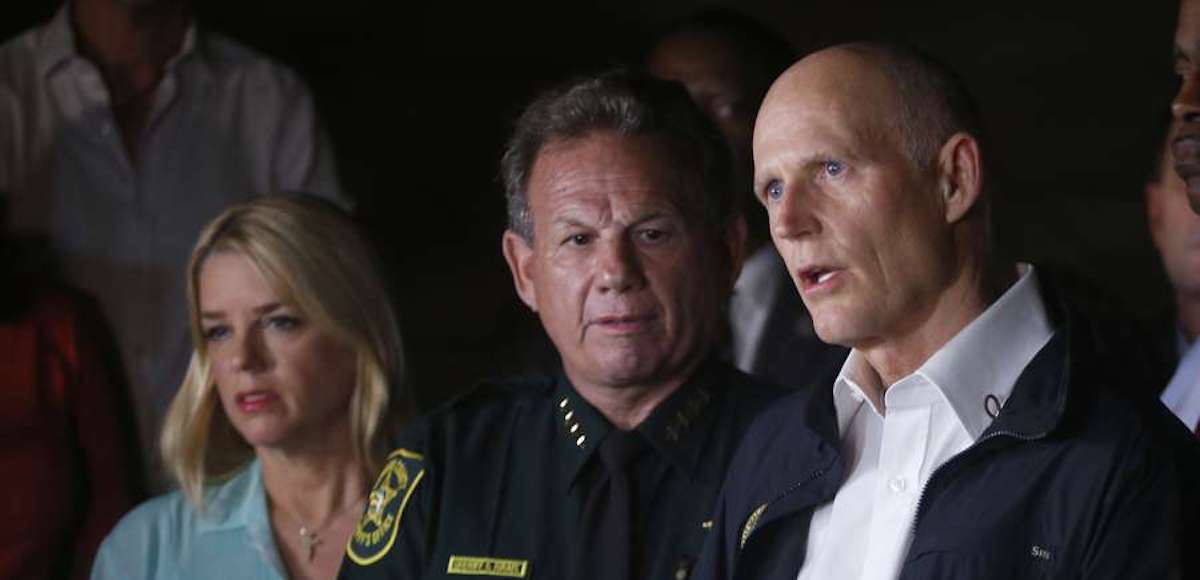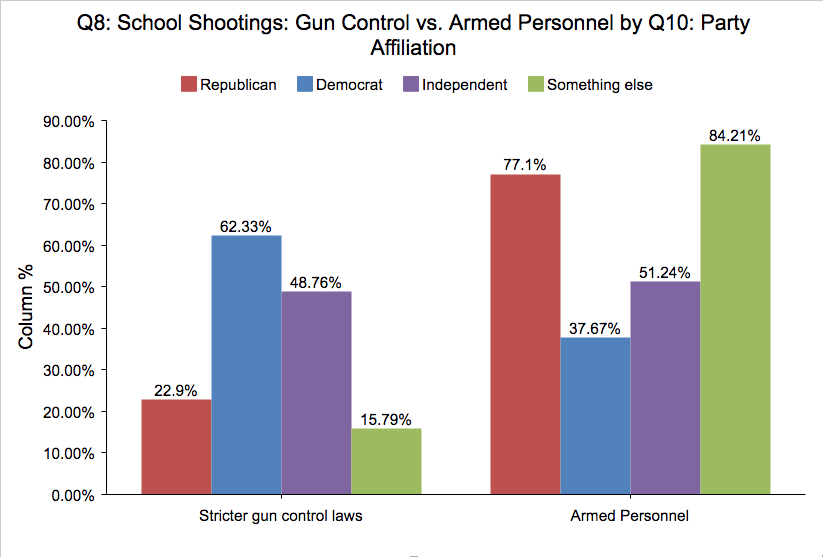

Florida Governor Rick Scott, foreground, speaks along with Sheriff Scott Israel, center, of Broward County, and Pam Bondi, Florida Attorney General, during a news conference near Marjory Stoneman Douglas High School in Parkland on Wednesday, February 14, 2018. (Photo: AP)
The PPD-BDP Sunshine State Battleground Poll finds Florida voters favor posting armed personnel on campus during school hours to prevent mass shootings over stricter gun control laws. Last week, 19-year-old Nikolas Cruz shot and killed 17 people at Marjory Stoneman Douglas High School in Parkland, Florida.
The tragedy has sparked a renewed push from Democrats for stricter gun control laws.
Overall, 56.7% say placing “armed security, police and trained personnel on campus during school hours” will “do the most to reduce the number of school shootings.” That compares to just 43.3% who think “stricter gun control laws” are needed.
However, voters are evenly divided over the need for stricter gun control laws versus mental health reforms in general, 50.4% to 49.6%, respectively. That’s a change from past surveys conducted by Big Data Poll, which typically found mental health reforms more popular. While only about 31% of Republican voters in Florida support beefing up gun control laws over mental health laws, roughly 68% of Democrats and 52% of independents, agree.
“I suspect this is a reaction to the tragedy last week and more than likely a temporary one, but it’s too soon to know for certain,” Rich Baris, the director of Big Data Poll said. “Support among independents and Republicans isn’t particularly firm.”


Source: Big Data Poll
The PPD-Big Data Poll Battlegrounds conducted highly-accurate statewide surveys in 2016, including in the state of Florida. The Sunshine State Battleground released on November 6 found Donald Trump leading Hillary Clinton by 1.6%, rounded up to two points.
He won by 1.2%.
Can’t read the crosstabs? View them on Google Sheets!
BDP Sunshine State Battleground Poll Questionnaire 02-18*
AAPOR Transparency Initiative Checklist PPD-BDP Sunshine State Battleground Poll Feb
*(Big Data Poll logo on the survey questionnaire is NOT visible to panel respondents.)
Big Data Poll conducted the mixed-mode survey of 910 registered voters in Florida from February 17 to 18, 2018. The survey has margin of error is +/- 3 percentage points with a 95% level of confidence. The mixed-mode breakdown was a total of 609 interviews conducted using interactive voice response (IVR) and 301 conducted by online survey panel (OSP).
The data are weighted for age, gender, race/ethnicity, education and income based on projected voter turnout. Partisan affiliation is derived from a proprietary likely voter model and demographic weighting, not the other way around.
The sample identified a partisan split of 32.64% Republican, 32.09% Democrat, 31.10% Independent and 4.18% “Something Else.” Read about methodology here.
The most damning journalistic sin committed by the media during the era of Russia collusion…
The first ecological study finds mask mandates were not effective at slowing the spread of…
On "What Are the Odds?" Monday, Robert Barnes and Rich Baris note how big tech…
On "What Are the Odds?" Monday, Robert Barnes and Rich Baris discuss why America First…
Personal income fell $1,516.6 billion (7.1%) in February, roughly the consensus forecast, while consumer spending…
Research finds those previously infected by or vaccinated against SARS-CoV-2 are not at risk of…
This website uses cookies.
View Comments
@seriousserb This just makes sense.
@LarrySchweikart Makes sense https://t.co/JgfLKgLMuu
@SpringerBrent1 That’s the way it should be!
Roger on That! ??
@LarrySchweikart Because most people are intelligent enough to understand the difference of a real solutio… https://t.co/UIDMojSBOq
@AnilNS425 Yep, no more gun free zones.
@Fingersflying Guards at airports, banks, office buildings, hospitals. Are they more important than our children?
@LarrySchweikart The overreach of Obama and the Clintons have taught Americans not to ever trust the gover… https://t.co/tu1piaifaA
@LarrySchweikart Picked up my 7 yr old granddaughter in carpool last week, armed guard greeted me.
@VikkiVeach1 It makes sense otherwise the students have no out at all.